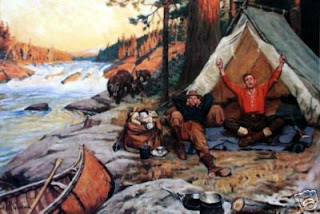 Many log homes and cabins have trusses that support the roof structure. The trusses accent the open ceiling and give the log home a sense of "structure".
Many log homes and cabins have trusses that support the roof structure. The trusses accent the open ceiling and give the log home a sense of "structure".The choice of truss configuration is based on the skill of the workmanship, cost, joinery and, most of all, aesthetics.
Trusses are expensive as they are time consuming to build and are labor intensive. The joinery is the major consideration as the truss members are pieced together by a variety of methods. Usually the trusses are pre-built; that is, they are assembled off site or on the ground at the site and lifted into place by a mobile crane.
The trusses should be engineered. Calculations based on the prevailing snow and wind loads of the area should be determined along with truss member sizes and the timber specie. I like to use rectangular sections of timbers, such as 4"x6", 6"x6", 6"x8", or 6"x10". The timbers are connected together with 3/4" round Thru-bolts with 1/4" steel plates on each side of the timber members where connected to each other. Each connection should be calculated to determine the proper number of 3/4" Thru=bolts on each side of the joint.
Trusses are best used in large rooms. A room 24' x 24' would be an ideal space for one large truss that is spaced at approximately 12' on center. The span of the truss is 24'. Small roof purlins with a 4' spacing then can frame from the end walls to the truss. Of course, other truss spacing may be used, but aesthetics dictate a large spacing for the trusses with purlins at the underside of the roof slope providing a nice arrangement of the structural pieces.
There are many different truss configurations. Just to name a few; Queen, Fink, Howe and Pratt. If the truss span is in the 18' to 25' range, the most economical truss is probably the Fink truss as it has the minimum number of truss pieces; thus reducing the number of connections of member to member.
 The Fink truss has a straight bottom chord and sloping top chords that follow the slope of the roof. The web members; that is, the members that tie the top and bottom chords together form a "W" shape with the center of the "W" connecting at the ridge.
The Fink truss has a straight bottom chord and sloping top chords that follow the slope of the roof. The web members; that is, the members that tie the top and bottom chords together form a "W" shape with the center of the "W" connecting at the ridge. Other truss configurations are also used to create a more aesthetic arrangement of the structural pieces. Check with the builder or the log supplier as they may have a favorite truss to build.
Other truss configurations are also used to create a more aesthetic arrangement of the structural pieces. Check with the builder or the log supplier as they may have a favorite truss to build.



